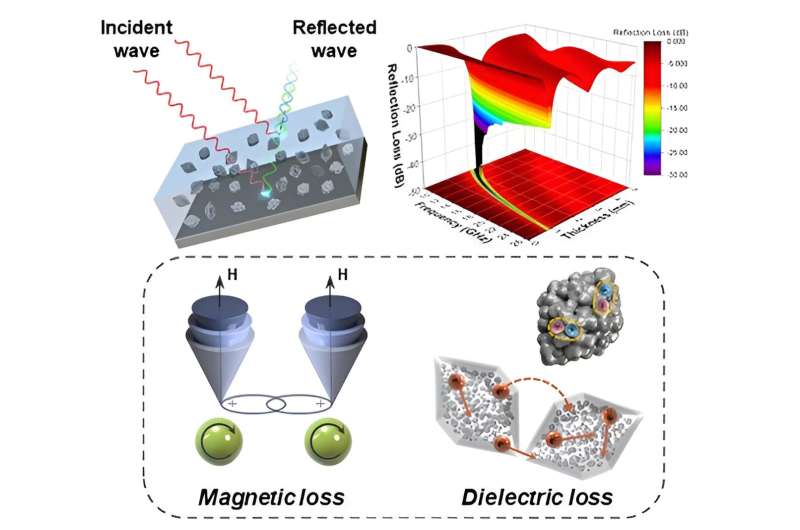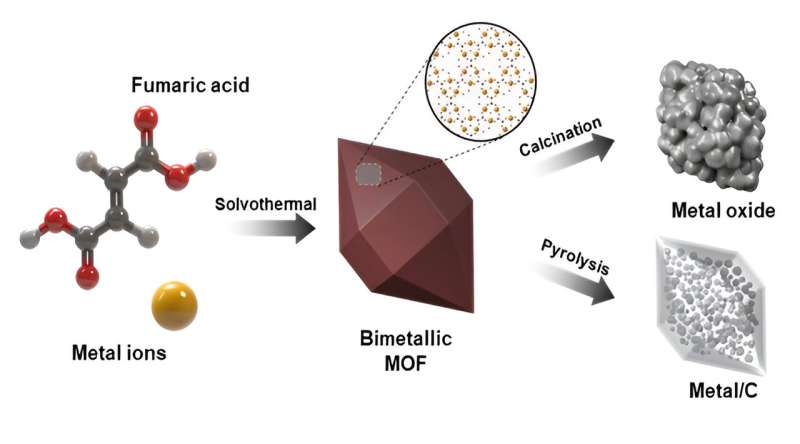This article has been reviewed according to Science X's editorial process and policies. Editors have highlighted the following attributes while ensuring the content's credibility:
fact-checked
trusted source
proofread
Research team develops electromagnetic wave absorbers with strong absorption and broad effective bandwidth

A research team from the Department of Functional Composites in Composites Research Division at Korea Institute of Materials Science (KIMS) has successfully developed electromagnetic wave absorbers based on metal-organic frameworks (MOFs) that enhance dielectric and magnetic losses in the gigahertz (GHz) frequency band. The research was published in the journal Advanced Composites and Hybrid Materials on February 5, 2024.
The team, led by Dr. Hee Jung Lee, has compounded MOFs with thermoplastic polyurethane to produce a high-performance and broadband-absorption composite.
Previous research focused on developing electromagnetic wave-absorbing materials using highly conductive and dielectric materials, however, it faced challenges in achieving appropriate complex permittivity and permeability during the fabrication of the composites. This resulted in increased thickness and limited narrow-band absorption performance.
The electromagnetic wave absorbing material developed by Dr. Lee's team not only improves the absorption performance compared to conventional materials but also exhibits high reflection loss and wide absorption bandwidths at lower thicknesses. This research presents a new strategy to serve as a promising approach for developing high-potential electromagnetic wave absorbers.
The research team optimized the material composition to enhance the electromagnetic wave absorption and synthesized the MOF using a solvothermal method.
After thermal treatment process, the MOF was compounded with thermoplastic polyurethane to produce the electromagnetic wave absorbing material. The material demonstrated high absorption performance, reaching -52.29 decibels (dB; 99.999% absorption) at 10 gigahertz (GHz) and a thickness of 1.9 millimeters (mm). Notably, at a thinner thickness of 0.9 mm, it exhibited broadband absorption performance up to 7.23 GHz, representing a significant improvement over materials developed by other researchers.
The technology behind MOF-based electromagnetic wave absorbing materials has applications in stealth technology and various industrial fields such as electrical, electronic, autonomous driving, and communications. It especially prevents electromagnetic pollution, which is an undesirable and uncontrolled off-shoot resulting from electromagnetic interference. Consequently, it could be promisingly utilized in the next-generation IT field leading to the activation of private companies as well as the defense industry with the reinforcement of national defense.

Senior researcher Dr. Hee Jung Lee, emphasized the objective to apply MOF materials across overall industrial sectors and expand into environmental and bio fields through mass production. She highlighted the potential for developing proprietary technology domestically and exporting it overseas in the future.
The research team is currently working on further developing electromagnetic wave absorption technology for higher frequencies in 5G-compatible bands. Additionally, they are actively facilitating the commercialization of high-value-added industrial applications such as electromagnetic wave absorption, shielding, and heat dissipation by applying tailor-fitted MOF materials.
More information: Jae Ryung Choi et al, Synthesis of Fe/Co bimetallic metal–organic framework‐derived composites and their enhanced electromagnetic wave absorption, Advanced Composites and Hybrid Materials (2024). DOI: 10.1007/s42114-023-00824-z




















